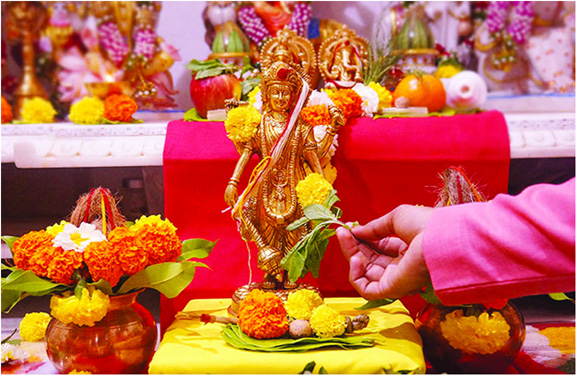
Phalguna Shukla Paksha Ekadashi is known as Amalaki Ekadashi. Amalaki Ekadashi falls between Maha Shivaratri and Holi. Currently it is observed in month of February or March in English calendar. Parana means breaking the fast. Ekadashi Parana is done after sunrise on next day of Ekadashi fast. It is necessary to do Parana within Dwadashi Tithi unless Dwadashi is over before sunrise. Not doing Parana within Dwadashi is similar to an offence. This year, Amalaki Ekadashi falls on March 14 Monday.
Parana should not be done during Hari Vasara. One should wait for Hari Vasara to get over before breaking the fast. Hari Vasara is first one fourth duration of Dwadashi Tithi. The most preferred time to break the fast is Pratahkal. One should avoid breaking the fast during Madhyahna. If due to some reasons one is not able to break the fast during Pratahkal then one should do it after Madhyahna.
At times Ekadashi fasting is suggested on two consecutive days. It is advised that Smartha with family should observe fasting on first day only. The alternate Ekadashi fasting, which is the second one, is suggested for Sanyasis, widows and for those who want Moksha. When alternate Ekadashi fasting is suggested for Smartha it coincides with Vaishnava Ekadashi fasting day.
Ekadashi fasting on both days is suggested for staunch devotees who seek for love and affection of Lord Vishnu.
Significance of Amalaki Ekadashi
Amalaki Ekadashi is a sacred fasting day for Hindus. It is believed that by observing this Ekadashi, the person reaches to the abode of lord Vishnu, ‘Vaikunth’. The rituals and significance of Amalaki ekadashi is mentioned in the ‘Brahmanda Purana’ and was also narrated by Saint ‘Valmiki’. There are innumerable stories and folk tales in the Hindu Puranas that speak of the greatness of the Amalaki Ekadashi fast. This day is known to be very auspicious and is marked with special ritual and prayers. Even the day after Amalaki Ekadashi, recognized as ‘Govinda Dwadashi’ is believed to be highly fortunate.
The day of Amalaki Ekadashi is considered more significant owing to its relation to other Hindu festivals. This ekadashi falls between Maha Shivratri and Holi. The worshipping of amla tree on this day is a symbolic representation of the elaborate Hinduism practice. During this occasion, Goddess Lakshmi is also worshipped as She is known to be an omnipresent deity. It is also a widespread belief that Lord Krishna with His consort, Goddess Radha also resides near the tree. Devotees worship amla tree to gain good health and wealth.
Legend
According to one of the inscriptions, King Chitrasena along with his followers had observed the fast on Amlaki Ekadashi. During one of his hunting experiences, the king got captured by a group of demons. However, they were successfully destroyed after a divine power emerged from the body of King Chitrasena. After getting back the consciousness, the king learned that it was because of the Amalaki Ekadashi Vrat that he got protected.
Celebration and Rituals
After bathing in the river, devotees visit the temple of Lord Vishnu. They offer a pot filled with water, as well as a fine canopy, sandalwood, roli, flowers, diyas and aromatic incense to Amla tree. Brahmins are served with meals beneath the Amalaki tree. Most devotees observe a fast on this day and also perform all-night vigil, fasting, and worship Lord Vishnu Some devotees observe a partial fast, abstaining from food made of rice and grains.
– On the day of Amalaki Ekadashi, the devotees wake up at sunrise and get over with their morning rituals. They then worship Lord Vishnu and the sacred amla tree. A ‘sankalp’ is taken with sesame seeds and coins with the motive to attain moksha after death. After worshipping Lord Vishnu, the devotees pray to the Amalaka tree. They offer water, sandalwood, roli, chawal, flowers and incense sticks to the sacred tree. Following this the devotees offer food to a Brahmin, underneath the Amalaki tree. If the amla tree is unavailable, then the sacred Tulsi tree can be worshipped.
– On this day, the devotees observe a strict fast all day long and only food made from amla can be eaten. Some devotees also observe partial fast by simply avoiding food made from grains and rice. The observer of this vrat should also listen to the Amalaki Ekadashi vrat katha after finishing the puja rituals.
– The devotees stay awake all night on the day of Amalaki Ekadashi and chant the bhajans and rhymes in the name of Lord Vishnu.
Know why the Amla tree is worshipped
– Devotees of Lord Vishnu who observe Ekadashi fast believe that Amla tree is sacred. According to legends, Vishnu, Lakshmi, Damodara or Krishna and Radha are said to reside near the tree.
– The berries of the Amla tree are known for their great medicinal value and is widely used in Ayurvedic preparations. Amla tops the list of superfoods today as it is rich in Vitamin C, which boosts immunity. People who worship the Amala tree also prepare food items out of Amla on this day.
– People who observe Amalaki Ekadashi usually wake up early and take a bath before sunrise. Devotees of Lord Vishnu fast on Ekadashi to seek his blessings. A strict fast is an important part of Ekadashi and people eat the next day only after sunrise. Grains and cereals are not allowed during Ekadashi fast but many who are working have fruits and juices in the afternoon.
– People read the Ekadashi Vrat Katha around an Amla tree and offer coconut and flowers. After the puja, Ekadashi aarti is performed.





Be the first to comment